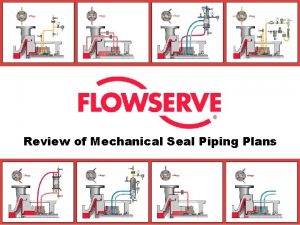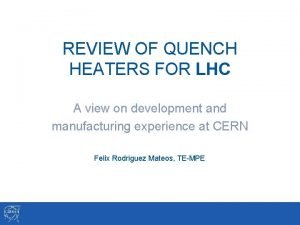MaxPlanckInstitut fr Plasmaphysik EURATOM Association The Quench DetectionWireFeedthrough

- Slides: 1

Max-Planck-Institut für Plasmaphysik, EURATOM Association The Quench Detection-Wire-Feedthrough Plug-In of W 7 -X Kerstin Rummel, Detlef Rademann, Olaf Volzke Max-Planck-Institut für Plasmaphysik, Euratom Association, Teilinstitut Greifswald, Wendelsteinstr. 1, D-17491 Greifswald, Germany Assembly Introduction and requirements For continuous on-line monitoring of the superconducting state 1624 Quench Detection-wires (QD-wires) are connected at the joints of the coils and the bus bars. The wires are bundled to 190 6 -wire cables and 121 4 -wire cables. The electrical potential of these wires must be fed through the Outer Vessel (OV) to the Quench Detection Units. Therefore, 10 QD-domes, i. e. two per module are provided on the OV. The QD-domes are differently located and oriented. Design of the Quench Detection-Wire-Feedthrough Plug-in (QD-plug-in) A test installation at the OV with a full-size prototype of a QD-Plug-in including making and testing the connection of QDDwires to QD-wires was successfully carried out to qualify the assembly procedure and train the assembly team. Special attention during this test was given to the support and handling of the 424 kg dome extension including QD-plug-in as well as the controlled overlap of MLI during alignment of the dome extension to the dome. Now the assembly at W 7 -X has been started. Two QD-Plug-ins for the first module 5 are pre-assembled. The installation of these QD-Plug-ins on the QD-domes is underway. Several constraints require a complex feedthrough system design: • maximum allowed integral helium leak-rate of one QD-dome 10 -8 mbar l/s. • maximum heat load to thermal shield of the OV 140 W • electrical insulation of the electrical feedthroughs for a nominal voltage to ground of 6 k. V DC and a related test voltage of 13 k. V DC under conditions close to the Paschen minimum (Paschen test) Fig. 1. 31 (32) x assembled socket Outside cryostat Lid Dome extension 31 (32) x QDD-cable Electrical feedthroughs in the lid Radiation shield Bronze sheet Copper plate Assembly procedure of the QD-plug-in on the QD-dome • Mounting the sockets in the lid • Paschen test at 10 k. V and leak test of the sockets • Mounting of plug-in-tube , radiation shied and base plate (fig. 11, 12) • Wrapping of MLI around the plug-in-tube • Inserting the QD-plug-in in the dome extension • Leak-test of the flange connection between lid and dome extension • • Fixing the QD-plug-in on the supports of the QD-dome (fig. 13, 14) Mounting of QD-connectors (fig. 15) Paschen test of each single connector at 5 k. V Installation of screen and strain relief at the connector Thermal connection of base plate to thermal shield of OV Inserting the QD-plug-in in the dome extension Leak-test of the flange connections • Nineteen 6 -wire cables and twelve 4 -wire cables respectively thirteen 4 -wire per dome • For commonly used weldable ceramic feedthroughs with 1 or 2 pins there is not enough available space on the lid several commercial types of multi-pin feedthroughs were tested 7 - and 4 -pin female sockets from the company LEMO were chosen (fig. 3) Plug-in-tube 4 ( 6) QD-domes of module 1: Inner diameter: 800 mm Average height: 500 mm Pre-assembly procedure of the QD-plug-in MLI Fig. 13. QD-Plug-in installed on the QD-dome Base plate Flange connection Strain relief Thermal Connection 31 (32) x connector Fig. 11. Pre-assembled QD-plug-in without dome extension Fig. 3. Electrical socket Fig. 4. Cross section of a socket QD-dome 4 ( 6) • Design of QD-plug-in allows the replacement of O-rings Outer vessel QD-cable tray Thermal Shield (70 K) Fig. 2. QD-Plug-in • The design of the QD-plug-in (fig. 2) was mainly driven by thermal losses to thermal shield of the cryostat. • • Copper of the conductor was replaced by constantan Copper of the shield was replaced by stainless steel Thermal contact to the base plate is minimized by using thermal insulated strain reliefs 134 W MT-22, Marseille, France, September 2011 • • Electrical tests Small, reliable, applicable for 4 and 6 -wire cables and easy to install Consists of three pieces made of G 10 and hoses of polyethylene (fig. 6) Hoses of PE protect the wires against too strong bending at the edge of G 10 For the 4 -wire cables two holes in the center piece will be closed by epoxy Parts will be glued together and put over the wires (fig. 7 -9) Soldering point will be placed in the middle of the separator • Filling Stycast in the seventh hole in the center (fig. 10) • Grooves in the center piece guarantee the flow of Stycast to the other holes • The level of Stycast in all seven holes and between the separator and sleeve rise uniformly • Numerous connectors were mechanically overstressed by bending the wires and then thermal cycled. All qualification samples have been passed successfully the Paschen test at 13 KV. groove center piece separator Fig. 6. Parts of QD-connector Fig. 15. Installation of QD connectors Fig. 12. QD-plug-in wrapped with MLI Electrical connectors Thermal losses Thermal radiation: depends on the surfaces, emissivity and the temperature distribution along the plug-in-tube. 30 W Thermal conduction: depends on the cross section of conductor and shield of the 1. 4 long QD-wires and on the 600 mm long stainless steel tube. 202 W Fig. 5. Sockets in the lid (view from vacuum side) • Sockets were assembled with 1. 4 m long QDD-cables by the Lemo • To obtain the high voltage characteristics at different pressures the soldered pins to the wires are potted in Stycast (fig. 4) • Not connected seventh pin is connected to one of the other pins • After mounting the sockets in the lid Paschen tests and leak-tests are performed (fig. 5) 31 (32) x QD-cable Inside cryostat Fig. 14. View on the lid sleeve Fig. 7. QD-connector Fig. 8. Assembly of Fig. 9. Soldering of wires QD-connector Fig. 10. Filling of Stycast • To proof the electrical characteristic small chambers were designed to make a Paschen-test for each single QD-connector (fig. 16) • They makes it possible to perform high voltage test under different air and Helium pressures on-site. • Test voltage of 5 k. V, allowed leakage current 5 µA • During the Paschen test the work on the W 7 -X must be stopped simultaneous tests of much as possible QD-connectors are required simultaneous tests of the QD connectors of one electrical circuit for both QD-Plug-ins Only 7 tests compared to 64 tests with one chamber Fig. 16. Chamber for Paschen test

